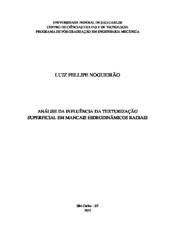| dc.contributor.author | Nogueirão, Luiz Fellipe | |
| dc.date.accessioned | 2023-05-29T13:59:52Z | |
| dc.date.available | 2023-05-29T13:59:52Z | |
| dc.date.issued | 2023-02-23 | |
| dc.identifier.citation | NOGUEIRÃO, Luiz Fellipe. Análise da influência da texturização superficial em mancais hidrodinâmicos radiais. 2023. Dissertação (Mestrado em Engenharia Mecânica) – Universidade Federal de São Carlos, São Carlos, 2023. Disponível em: https://repositorio.ufscar.br/handle/ufscar/18081. | * |
| dc.identifier.uri | https://repositorio.ufscar.br/handle/ufscar/18081 | |
| dc.description.abstract | The use of textured surfaces can be observed in several applications where an improvement of a certain characteristic of the product or process is sought, with the aim of changing the conditions of friction, wear, and lubricant. When it comes to hydrodynamic radial bearings, one way to analyze the involved tribological parameters is through the Reynolds equation. A literature review is conducted to identify static analysis methods for textured hydrodynamic radial bearings. A correlation between the types of boundary conditions is conducted with considerations regarding the phenomenon of cavitation, which proves to be necessary to be included in the analysis of textured bearings. The correlation is consistent with historical progress, which starts with conditions that do not include cavitation effects (Half-Sommerfeld/Gümbel conditions); evolving to conditions that included cavitation effects, but in an exaggerated way by not considering the conservation of mass in the oil film (Reynold’s/Swift-Stieber conditions); and finally resulting in the cavitation theory, which considers the conservation of mass, of Jakobsson-Flober-Olsson (JFO). A computational program capable of analyzing the influence of texturing in radial hydrodynamic bearings is elaborated, considering the effects of cavitation with conservation of mass. The routine is validated with results from the literature and commercial software. The limitation in the discretization of textures as a function of the applied mesh size is analyzed. Finally, a series of analyzes are conducted with different cases of distribution of textures on the bearing. It is concluded that texturing can be satisfactory or harmful to the load capacity of the bearing, depending on the textured region. The texturing of the bearing in the central region shows on all cases harmful, while texturing in the converging and diverging regions of the pressure field can bring higher values for the load capacity. | eng |
| dc.description.sponsorship | Não recebi financiamento | por |
| dc.language.iso | por | por |
| dc.publisher | Universidade Federal de São Carlos | por |
| dc.rights | Attribution 3.0 Brazil | * |
| dc.rights.uri | http://creativecommons.org/licenses/by/3.0/br/ | * |
| dc.subject | Tribologia | por |
| dc.subject | Engenharia de superfície | por |
| dc.subject | Cavitação | por |
| dc.subject | Conservação de massa | por |
| dc.subject | Superfície texturizada | por |
| dc.title | Análise da influência da texturização superficial em mancais hidrodinâmicos radiais | por |
| dc.title.alternative | Analysis of the influence of surface texturing in radial hydrodynamic bearings | eng |
| dc.type | Dissertação | por |
| dc.contributor.advisor1 | Watanabe, Flávio Yukio | |
| dc.contributor.advisor1Lattes | http://lattes.cnpq.br/6492641614740181 | por |
| dc.description.resumo | O uso de superfícies texturizadas pode ser observado em diversas aplicações onde se busca um aprimoramento de certa característica do produto ou processo, com o objetivo de alterar as condições de atrito, desgaste e lubrificação. Quando se trata de mancais radiais hidrodinâmicos, uma forma de se analisar os parâmetros tribológicos envolvidos é por meio da equação clássica de Reynolds. No presente trabalho, foi realizada uma revisão atual da literatura para identificação dos métodos de análise estática para mancais radiais hidrodinâmicos texturizados. A correlação dos tipos de condições de contorno com as considerações em relação ao fenômeno de cavitação, mostra que é necessário que este fenômeno dever ser incluído em análise de mancais texturizados. A correlação se mostra coerente com o progresso histórico, o qual se inicia com condições que não incluíam os efeitos de cavitação (condições de Half-Sommerfeld/Gümbel); evoluindo para condições que incluíam os efeitos de cavitação, mas de forma exagerada ao não se considerar a conservação de massa no filme de óleo (condições de Reynold’s/Swift-Stieber); e por fim resultando na teoria de cavitação com consideração da conservação de massa de Jakobsson-Flober-Olsson (JFO). Uma rotina computacional capaz de analisar a influência da texturização nos mancais hidrodinâmicos radiais foi elaborada, considerando os efeitos de cavitação com conservação da massa. A rotina é validada com resultados da literatura e de softwares comerciais. As limitações na discretização das texturas em função do tamanho de malha aplicada foram analisadas e uma série de análises com diferentes casos de distribuição das texturas no mancal foi desenvolvida. Conclui-se que a texturização pode ser benéfica ou maléfica à capacidade de carga do mancal, dependendo da região texturizada. A texturização do mancal na região central se mostra prejudicial em todos os casos, enquanto a texturização nas regiões convergentes e divergentes do campo de pressão podem trazer valores mais elevados para a capacidade de carga. | por |
| dc.publisher.initials | UFSCar | por |
| dc.publisher.program | Programa de Pós-Graduação em Engenharia Mecânica - PPGEMec | por |
| dc.subject.cnpq | ENGENHARIAS::ENGENHARIA MECANICA::PROJETOS DE MAQUINAS | por |
| dc.publisher.address | Câmpus São Carlos | por |
| dc.contributor.authorlattes | http://lattes.cnpq.br/5083911710557556 | por |
| dc.contributor.authororcid | https://orcid.org/0000-0003-1591-1168 | por |

